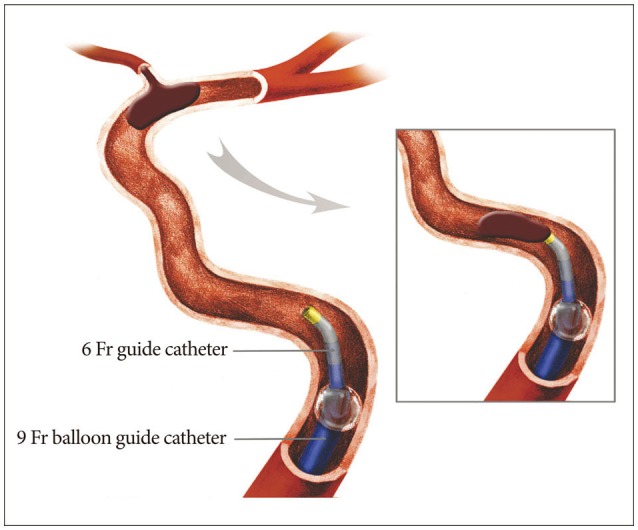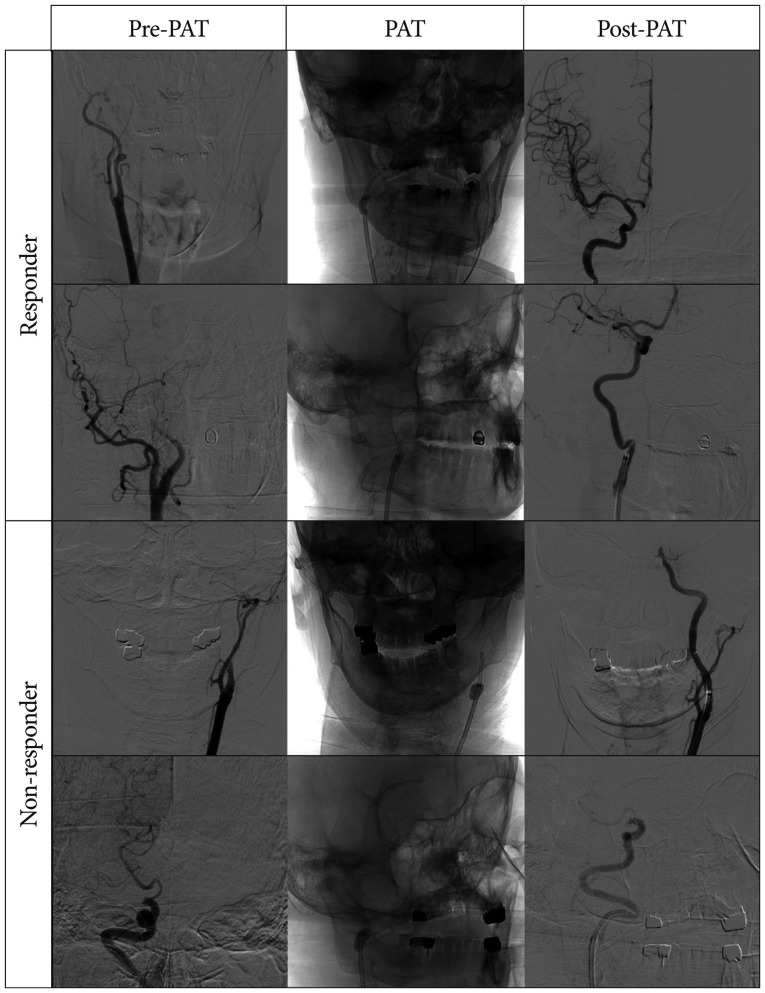Efficacy of Proximal Aspiration Thrombectomy for Using Balloon-Tipped Guide Catheter in Acute Intracranial Internal Carotid Artery Occlusion
- Affiliations
-
- 1Department of Radiology, Cerebrovascular Center, Kyungpook National University Hospital, School of Medicine, Kyungpook National University, Daegu, Korea. kdhdock@hotmail.com
- 2Department of Neurology, Cerebrovascular Center, Kyungpook National University Hospital, School of Medicine, Kyungpook National University, Daegu, Korea.
- 3Department of Neurosurgery, Cerebrovascular Center, Kyungpook National University Hospital, School of Medicine, Kyungpook National University, Daegu, Korea.
- KMID: 2315974
- DOI: http://doi.org/10.3340/jkns.2016.59.4.379
Abstract
OBJECTIVE
Mechanical thrombectomy (MT) for acute intracranial internal carotid artery (ICA) occlusion is often complicated by difficult revascularization and non-involved territory embolization possibly related with larger clot-burden. This study aims to evaluate the efficacy of proximal aspiration thrombectomy (PAT) using a balloon-tipped guide catheter for clot-burden reduction in such cases with period-to-period analysis (period 1 : standard MT without PAT; period 2 : PAT first, then standard MT for the remaining occlusion).
METHODS
Eighty-six patients who underwent MT for acute intracranial ICA occlusion were included in this analysis from the prospectively maintained stroke registry (33 patients in period 1 and 53 in period 2). In period 2, 'responder' was defined as a case where some amount of clot was retrieved by PAT and the following angiography showed partial or full recanalization.
RESULTS
Fifteen of fifty-three patients in period 2 (28.3%) were 'responders' to PAT. There was a significantly higher incidence of atrial fibrillation in the 'responder' subgroup. Period 2 showed a significantly shorter puncture-to-reperfusion time (94.5 minutes vs. 56.0 minutes; p=0.002), a significantly higher Thrombolysis in Cerebral Infarction of 2b-3 reperfusion (45.5% vs. 73.6%; p=0.009), but only a trend for better 3-month favorable outcome (mRS 0-2; 36.4% vs. 54.7%; p=0.097). There was no increase in the incidence of procedure-related complications or intracranial hemorrhage in period 2.
CONCLUSION
A strategy of PAT before standard MT may result in shorter puncture-to-reperfusion time and better angiographic outcome than a strategy of standard MT for acute intracranial ICA occlusion.
Keyword
MeSH Terms
Figure
Cited by 3 articles
-
Factors Contributing to an Efficacious Endovascular Treatment for Acute Ischemic Stroke in Asian Population
Jin Soo Lee, Yang-Ha Hwang, Sung-Il Sohn
Neurointervention. 2021;16(2):91-110. doi: 10.5469/neuroint.2020.00339.Temporal Changes in Care Processes and Outcomes for Endovascular Treatment of Acute Ischemic Stroke: Retrospective Registry Data from Three Korean Centers
Jin Soo Lee, Seong-Joon Lee, Ji Man Hong, Jin Wook Choi, Jeong-Ho Hong, Hyuk-Won Chang, Chang-Hyun Kim, Yong-Won Kim, Dong-Hun Kang, Yong-Sun Kim, Bruce Ovbiagele, Andrew M. Demchuk, Yang-Ha Hwang, Sung-Il Sohn
Neurointervention. 2018;13(1):2-12. doi: 10.5469/neuroint.2018.13.1.2.Role of Balloon Guide Catheter in Modern Endovascular Thrombectomy
Ju-Yu Chueh, Dong-Hun Kang, Byung Moon Kim, Matthew J. Gounis
J Korean Neurosurg Soc. 2020;63(1):14-25. doi: 10.3340/jkns.2019.0114.
Reference
-
1. Barreto AD, Albright KC, Hallevi H, Grotta JC, Noser EA, Khaja AM, et al. Thrombus burden is associated with clinical outcome after intra-arterial therapy for acute ischemic stroke. Stroke. 2008; 39:3231–3235. PMID: 18772444.
Article2. Bhatia R, Hill MD, Shobha N, Menon B, Bal S, Kochar P, et al. Low rates of acute recanalization with intravenous recombinant tissue plasminogen activator in ischemic stroke : real-world experience and a call for action. Stroke. 2010; 41:2254–2258. PMID: 20829513.
Article3. Eesa M, Almekhlafi MA, Mitha AP, Wong JH, Goyal M. Manual aspiration thrombectomy through balloon-tipped guide catheter for rapid clot burden reduction in endovascular therapy for ICA L/T occlusion. Neuroradiology. 2012; 54:1261–1265. PMID: 22552837.
Article4. Gralla J, Burkhardt M, Schroth G, El-Koussy M, Reinert M, Nedeltchev K, et al. Occlusion length is a crucial determinant of efficiency and complication rate in thrombectomy for acute ischemic stroke. AJNR Am J Neuroradiol. 2008; 29:247–252. PMID: 17974616.
Article5. Higashida RT, Furlan AJ, Roberts H, Tomsick T, Connors B, Barr J, et al. Trial design and reporting standards for intra-arterial cerebral thrombolysis for acute ischemic stroke. Stroke. 2003; 34:e109–e137. PMID: 12869717.
Article6. Hong KS, Ko SB, Lee JS, Yu KH, Rha JH. Endovascular recanalization therapy in acute ischemic stroke : updated meta-analysis of randomized controlled trials. J Stroke. 2015; 17:268–281. PMID: 26437993.
Article7. Hwang YH, Kang DH, Kim YW, Kim YS, Park SP, Suh CK. Outcome of forced-suction thrombectomy in acute intracranial internal carotid occlusion. J Neurointerv Surg. 5(Suppl 1):2013; i81–i84. PMID: 22544821.
Article8. Kang DH, Hwang YH, Kim YS, Park J, Kwon O, Jung C. Direct thrombus retrieval using the reperfusion catheter of the penumbra system : forced-suction thrombectomy in acute ischemic stroke. AJNR Am J Neuroradiol. 2011; 32:283–287. PMID: 21087940.
Article9. Kang DH, Kim YW, Hwang YH, Park J, Hwang JH, Kim YS. Switching strategy for mechanical thrombectomy of acute large vessel occlusion in the anterior circulation. Stroke. 2013; 44:3577–3579. PMID: 24021683.
Article10. King S, Khatri P, Carrozella J, Spilker J, Broderick J, Hill M, et al. Anterior cerebral artery emboli in combined intravenous and intra-arterial rtPA treatment of acute ischemic stroke in the IMS I and II trials. AJNR Am J Neuroradiol. 2007; 28:1890–1894. PMID: 17898199.
Article11. Lee HG, Rhim JK, Kim YH, Sheen SH, Oh SH, Chung BS. The comparison of outcome between thromboaspiration and aggressive mechanical clot disruption in treating hyperacute stroke patients. J Korean Neurosurg Soc. 2011; 50:311–316. PMID: 22200012.
Article12. Lutsep HL, Clark WM, Nesbit GM, Kuether TA, Barnwell SL. Intra-arterial suction thrombectomy in acute stroke. AJNR Am J Neuroradiol. 2002; 23:783–786. PMID: 12006277.13. Machi P, Costalat V, Lobotesis K, Maldonado IL, Vendrell JF, Riquelme C, et al. Solitaire FR thrombectomy system : immediate results in 56 consecutive acute ischemic stroke patients. J Neurointerv Surg. 2012; 4:62–66. PMID: 21990438.
Article14. Mokin M, Setlur Nagesh SV, Ionita CN, Levy EI, Siddiqui AH. Comparison of modern stroke thrombectomy approaches using an in vitro cerebrovascular occlusion model. AJNR Am J Neuroradiol. 2015; 36:547–551. PMID: 25376809.
Article15. Nguyen TN, Malisch T, Castonguay AC, Gupta R, Sun CH, Martin CO, et al. Balloon guide catheter improves revascularization and clinical outcomes with the Solitaire device : analysis of the North American Solitaire Acute Stroke Registry. Stroke. 2014; 45:141–145. PMID: 24302483.16. Nogueira RG, Lutsep HL, Gupta R, Jovin TG, Albers GW, Walker GA, et al. Trevo versus Merci retrievers for thrombectomy revascularisation of large vessel occlusions in acute ischaemic stroke (TREVO 2) a randomised trial. Lancet. 2012; 380:1231–1240. PMID: 22932714.
Article17. Rha JH, Saver JL. The impact of recanalization on ischemic stroke outcome : a meta-analysis. Stroke. 2007; 38:967–973. PMID: 17272772.
Article18. Saver JL, Jahan R, Levy EI, Jovin TG, Baxter B, Nogueira RG, et al. Solitaire flow restoration device versus the Merci Retriever in patients with acute ischaemic stroke (SWIFT): a randomised, parallel-group, non-inferiority trial. Lancet. 2012; 380:1241–1249. PMID: 22932715.
Article19. Smith WS, Lev MH, English JD, Camargo EC, Chou M, Johnston SC, et al. Significance of large vessel intracranial occlusion causing acute ischemic stroke and TIA. Stroke. 2009; 40:3834–3840. PMID: 19834014.
Article20. Tan IY, Demchuk AM, Hopyan J, Zhang L, Gladstone D, Wong K, et al. CT angiography clot burden score and collateral score : correlation with clinical and radiologic outcomes in acute middle cerebral artery infarct. AJNR Am J Neuroradiol. 2009; 30:525–531. PMID: 19147716.
Article
- Full Text Links
- Actions
-
Cited
- CITED
-
- Close
- Share
- Similar articles
-
- Aspiration Clot Removal by Mannual Compression of Common Carotid Artery for Acute Internal Carotid Occlusion: a Case Report
- Effectiveness of Anchoring with Balloon Guide Catheter and Stent Retriever in Difficult Mechanical Thrombectomy for Large Vessel Occlusion
- Use of a Balloon Catheter for Occlusion of Iatrogenic Direct Carotid-Cavernous Fistula Occurring during a Neurointerventional Procedure
- Embolization of carotid-cavernous fistula using a silicone balloon and a tracker catheter system
- The Limitations of Thrombectomy with Solitaire(TM) AB as First-line Treatment in Acute Ischemic Stroke: A Single Center Experience



